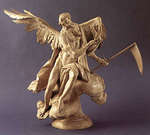Let's pick up where we left off on Tuesday . . . continue taking notes.
2. As a member of the audience, you will take notes and ask questions AFTER each presentation.3. After the presentations, you will complete a quick-write explaining which version of the afterlife is most like your own beliefs and understandings. Or, you may write about the version that is most different from your ideas or beliefs. (15 minute quick-write on Canvas - up to 5 minutes should be spent discussing your thoughts with others in the class. There will be 10 minutes of actual writing.)
4. Next we will travel back in time to the creation of the universe. Why would people want to know how the universe was created? What advantages would that knowledge provide?
Let's start with "In the beginning . . ." These are the famous words from the King James version of the Holy Bible. This creation story is nearly the same for those of the Christian, Jewish, or Islamic faith. Depending on the version, the exact details may differ, but the premise of the creation remains constant throughout those three major belief systems.
https://www.kingjamesbibleonline.org/ Hope you like Shakespeare! The language in this version will seem somewhat Shakespearean as this version was compiled at the same time that Shakespeare wrote. More contemporary versions are available as are versions from various Christian, Jewish, and Islamic groups.
Note what happened on each of the six days. (Anyone care to illustrate on the board for us? MANY colored markers are available for your artistic talents to shine! Remember, your teacher is a fan of stick figures!)
5. Now it is time to visit other cultures. We will look at 25 versions of creation. https://list25.com/25-creation-stories-from-around-the-world/
Homework: Select two of the cultures and dig deeper. Find additional details. Obvious, in 14 minutes, the video did not give all of the information.
What did you find? How did the research go? Do you need more time?
For each culture, complete the following:
A. Identify the culture by location, time, and importance. Was this a culture that ruled the world, or was this a culture limited to a smaller location and influence?
B. In bulleted format, tell the story in chronological order. What happened first, next, and then? Be sure to give credit to your sources. (Do you know how to use EasyBib?)
(By the way, did you know that the word "chronological" comes from the Greek god Chronos?)
Chronos is the personification of time in Greek mythology. He was considered to have the shape of a three-headed serpent. The heads were those of a man, a bull and a lion. Along with his daughter Ananke, the goddess of inevitability who was also in the form of a snake, he revolved around the primordial world egg, until they split it apart to form the earth, the sea and the sky. According to the Orphic cult, Chronos gave birth to Aether and Chaos, and created a silver egg in Aether. Out of the egg eclosed the gods Phanes and Hydrus, who later gave birth to the first gods and the universe. Sometimes, Chronos was confused with the Titan god Cronus by mistake, or conflated with him on purpose.
Yes, this is a creation story of sorts.
C. After reporting on two creation stories, complete a chart that shows how the stories were similar and how they differed. Various types of comparison/contrast charts may be found at: https://www.readingquest.org/compare.html Simply create in Word for ease of posting in Canvas.
Our own EMCC library have many books available. Many may be read online - save the gasoline!
This link give stories from many cultures: http://www.gly.uga.edu/railsback/CS/CSIndex.html
You also have a Mythology text!
Please conduct a bit of research on your own. These are not the only places where you can find information about creation stories. Again, be sure to give credit to your source.
What two cultures did you select? Write your name and the cultures on the side board.
Homework: Nature Myths . . .
Locate, read, and be ready to tell of story of how something in the natural universe/world came to be.
Consider:
How tigers got their stripes
Why the wind blows
Why the moon changes in size
Why it rains
Etc . . . This is by no means an exhaustive list. Let's add to the possibilities!
Assignment:
1. Give the element of nature as the title.
Identify the culture and location (5 points)
2. Relate the story in points/bullets (10 points)
3. Provide a picture(10 points)
4. Give credit to your sources (5 points) YouTube has many viewing options. Conduct a quick Google search for options. The world is filled with stories of how things in the universe came to be.
5. Share the story in class. You have 2 1/2 minutes. (20 points)
(Post 1-4 in Canvas by Tuesday, February 4, 2020. )
